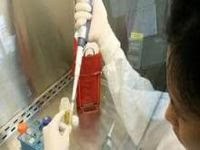Cuba is developing another cancer drug
Cancer, a term under which are grouped some 200 diseases, is currently the leading cause of death globally, causing approximately 7.7 million deaths each year (about 13 percent of the total).
The medium-term forecasts suggest an increase in the number of new cases due primarily to the aging population, high numbers of smokers and unhealthy lifestyles.
According to health statistics, the major sites for cancer in Cuba for men are lung and prostate, while for the women sites affected are breast and cervix.
As a consequence of the latter, about 400 women die every year on the island, despite being one of the most preventable types of cancer, detectable and treatable, as well as a national program in place for early diagnosis.
Therefore, Cuban researchers worked to find an effective drug for the treatment of cervical tumors, something that specialists have been working on for some years at the Center for Genetic Engineering and Biotechnology (CIGB).
Among these, according to a study made by a team of experts headed by Doctor of Science, Silvio Rodriguez Perea, the antitumor activity of a synthetic peptide capable of blocking the enzyme casein kinase two (CK2)is being explored, which causes the programmed death of tumor cells.
This molecule, very well known in the scientific community, had not been considered as an important object in the fight against cancer. However we have seen that it is over-expressed and overproduced in high levels in the majority of the types of this disease and this explains the relevance of analysing it, states Perea
CIGB-300, is the provisional name of the compound designed by experts that has already had positive results for a small group of patients, Perea explained to Prensa Latina.
We hope to get short-term therapeutic confirmatory studies to prove the efficacy of the drug, indicated not only for cancer of the uterus, but also for genital warts, asserted the scientist.
He also said that according to current trends in treatment, the molecule can be combined with traditional therapies, such as radiation or chemotherapeutic agents, he added.
The IGBC-300 exploits a new concept in oncology. There is no similar market, which is a challenge for Cuban science. However, there is still a long way to go, stated Perea.
Prevention remains the most important tool in the fight against cervical cancer, related to human papillomavirus (HPV), transmitted by sexual contact, early initiation of sexual intercourse, multiple pregnancies, addiction to smoking and immunosuppression.
Source: Prensa Latina
Translated from the Portguese version by:
Lisa Karpova
Pravda.Ru

Subscribe to Pravda.Ru Telegram channel, Facebook, RSS!


